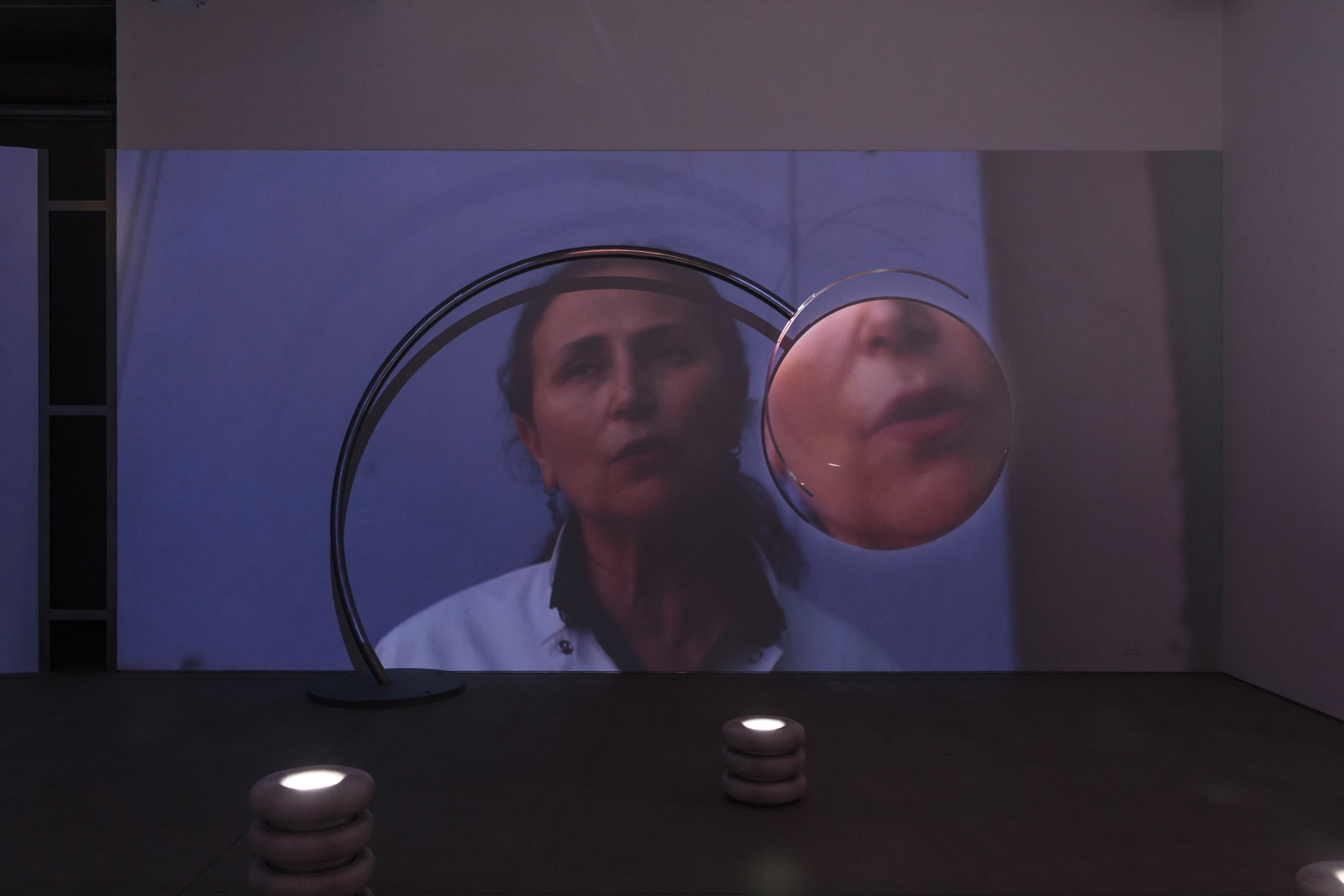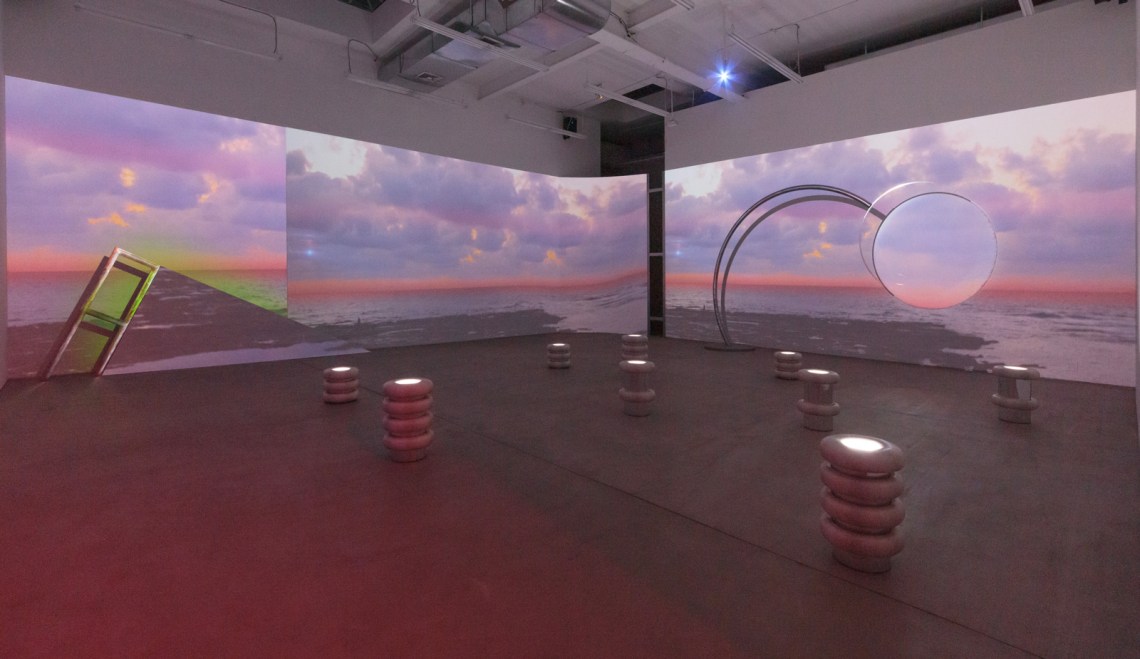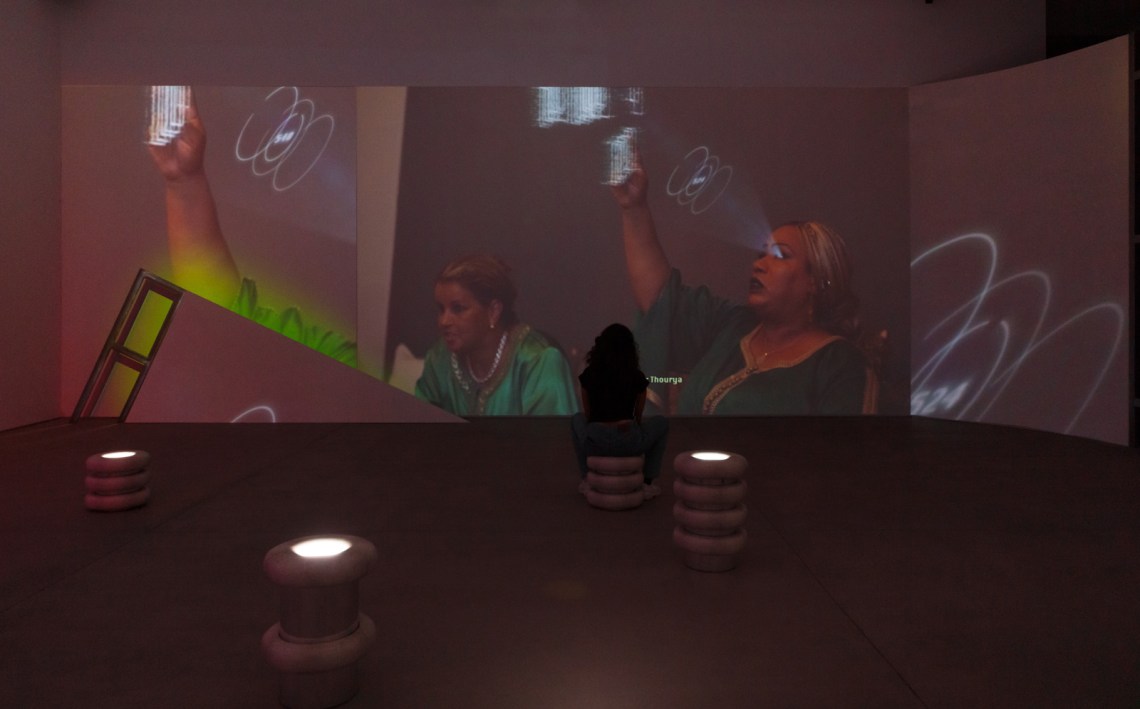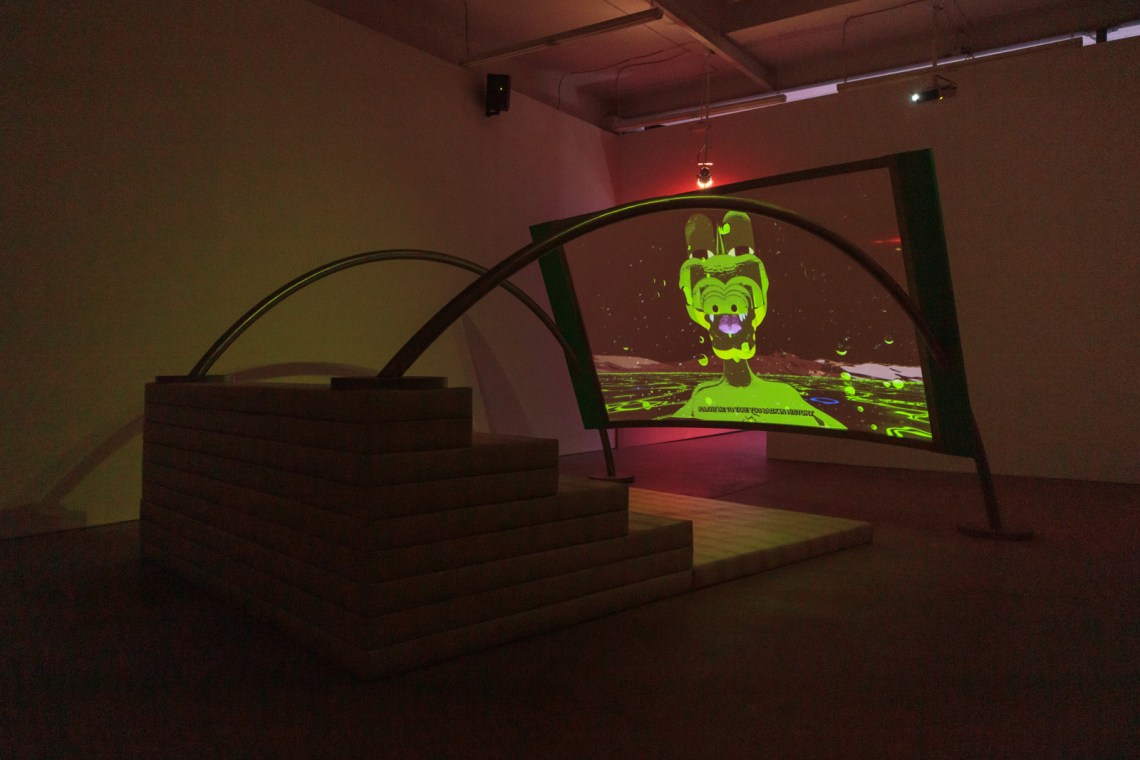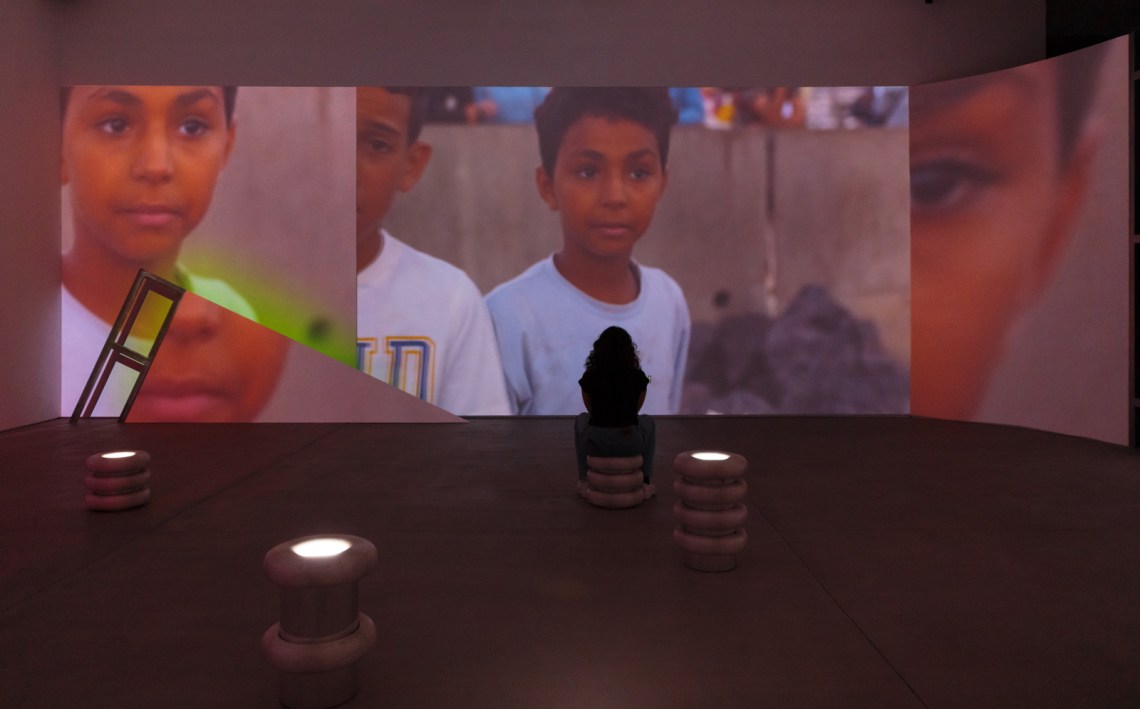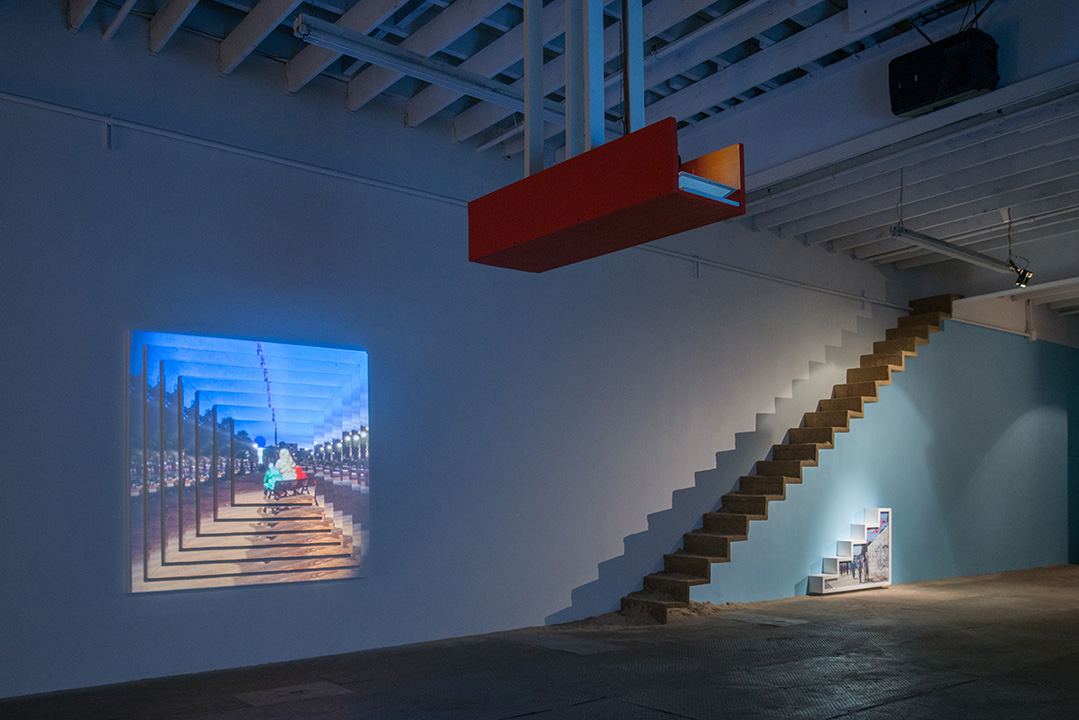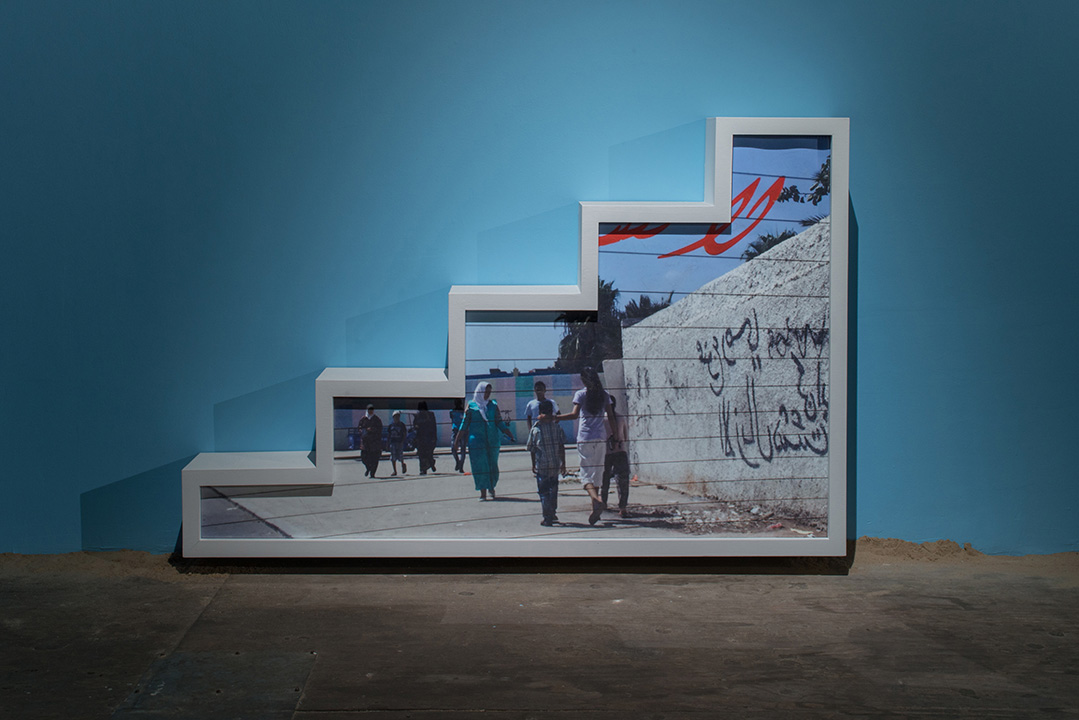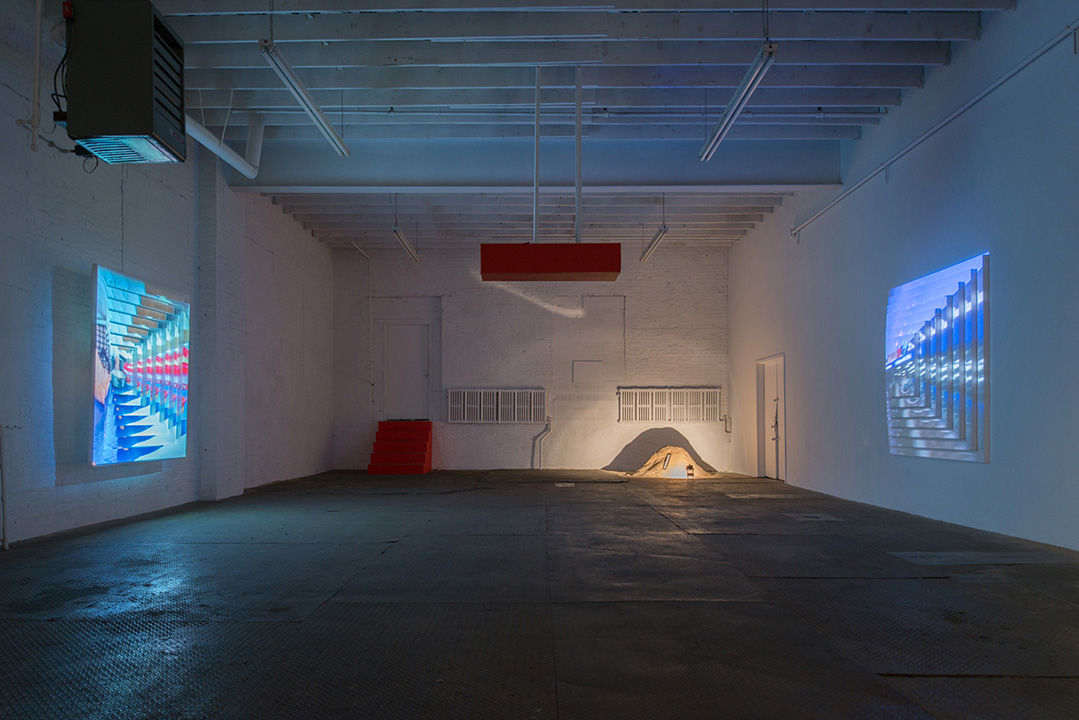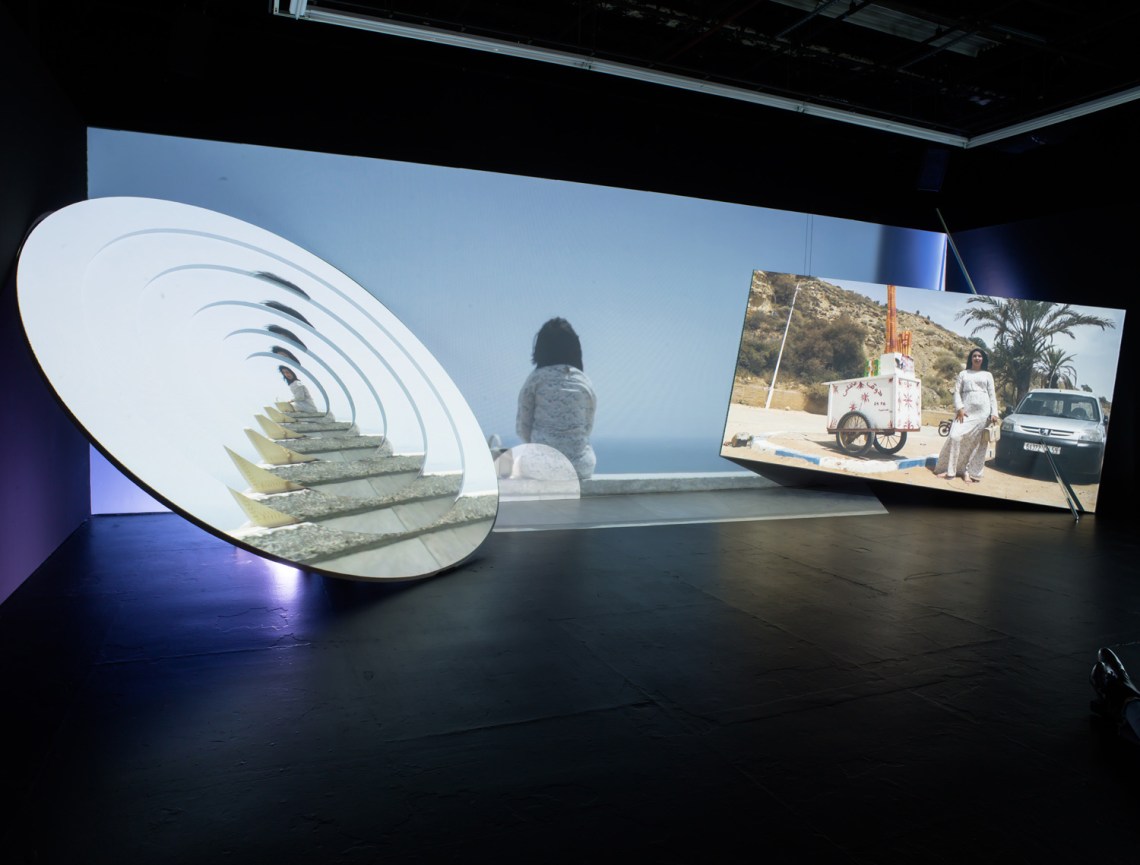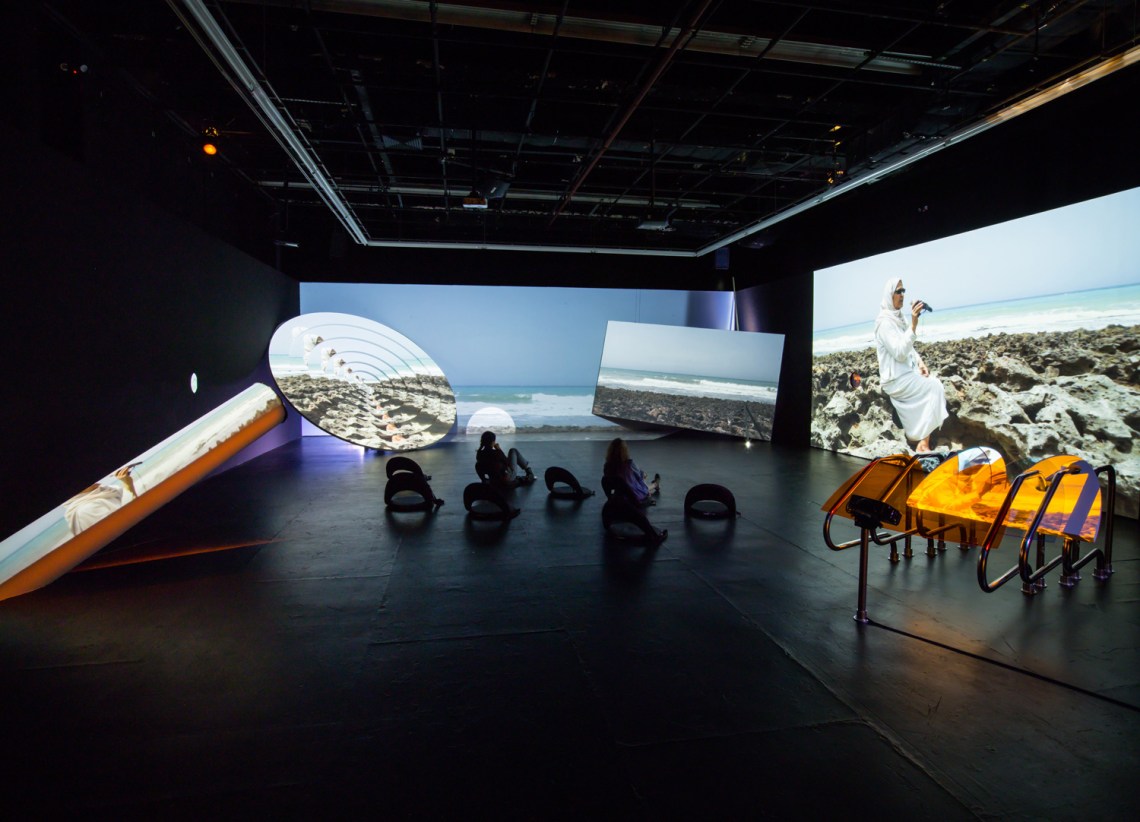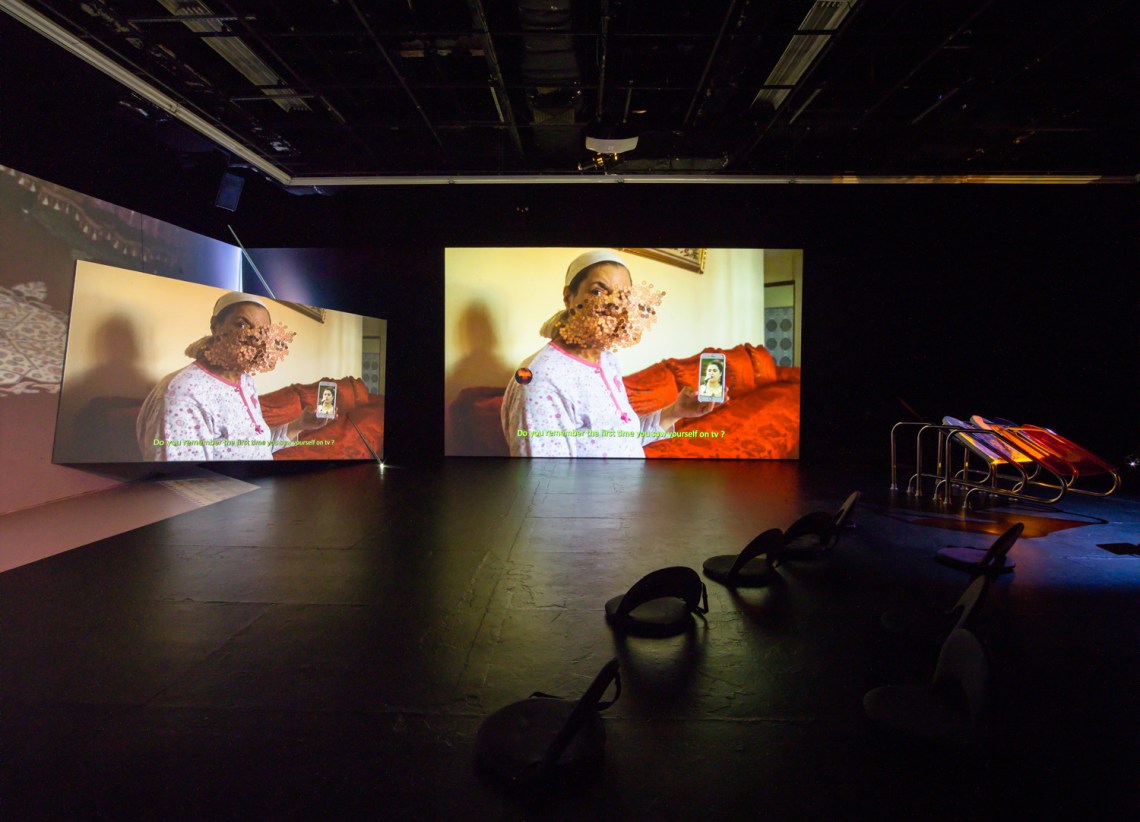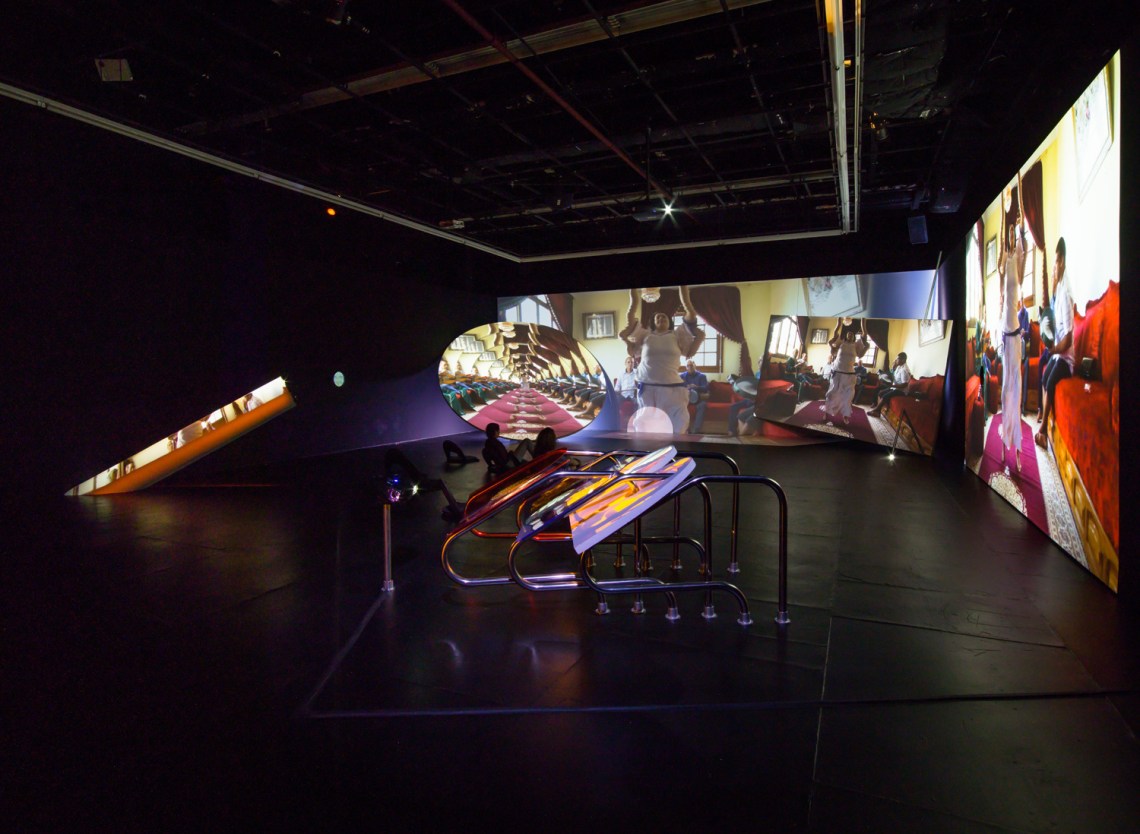“I was researching quantum physics and biotechnology when Donald Trump issued his travel ban at the end of 2017,” artist Meriem Bennani told Art in America magazine last month. Watching videos online, she became interested in quantum teleportation—physicists have succeeded in transporting quantum units—information about the precise state of an atom or particle—linking one photon in China to another in Vienna. Bennani began speculating, in the tradition of science fiction: Could we someday teleport people? When someone is disassembled and reassembled elsewhere, what is lost? Thinking of global migration, Bennani imagined the risky journey to another country via teleportation—how would American border police handle a technology that makes national boundaries physically insignificant?
The result is “Party on the CAPS,” an exhibition of video and sculpture at Brooklyn’s Clearing Gallery. Visitors first encounter a block of low stadium seating upholstered in polyester faux crocodile skin; on a screen looming above, a video narrated by an animated crocodile provides a brief orientation. We are on the CAPS, short for “Capsule”: an island in the middle of the Atlantic where migrants arrested mid-teleportation by US immigration forces (called “Troopers”) are detained. The process wreaks fantastical damage on migrants’ bodies: some suffer from ailments like “plastic face syndrome” or “mega ear,” and some never rematerialize at all. Decades of legislative inaction have transformed the CAPS from a temporary holding area to a metropolis; three generations live there, and the islanders have their own currency, homegrown technology, jokes, and traditions.
In the second gallery, a video plays on walls curved like a skateboarding ramp, projection-mapped across sculptures that resemble a giant magnifying glass and a triangular piece of flotsam, which appears to sink into the floor. It tells the story of a birthday party in the Moroccan neighborhood of the CAPS. Bennani has described it as a documentary, and although the premise is science-fiction, much of it was filmed at a six-hour-long party she threw in Rabat and cast with her family and friends, who improvised their lines. Bennani’s mother, Amal, had a dress made—dark green and glittery, with a high neck and puffed sleeves, a “theatrical version of a caftan”—to look properly futuristic. Teenagers wear sweatpants and hoodies and offer vaguely embarrassed smiles when the camera focuses on them. A singer at the party is played by Khadija El Ouarzazia, an actual performer of Chaabi and Houara music, two Moroccan folk genres. The MC is played by Lil Patty, a Moroccan rapper and social media star.
The film has its surreal elements: the birthday girl is turning eighty, but has just undergone an expensive “rejuvenation” surgery and looks a very brittle twenty; guests tip dancers by showering virtual coins from their hands; women gossip that an aunt must be dating a US Trooper because she was seen eating rare American M&Ms. But Bennani’s characterization of Party on the CAPS as a documentary emphasizes its depiction of a real event. Although the scenario is fictional, the film portrays an actual community and, in doing so, captures an experience of postcolonial dispossession and rage. “Whenever we throw a party, they send a fucking cop,” the MC shouts into the mic. “For no reason! But we celebrate.” He switches to Arabic. “Am I right?” The crowd cheers back.
Bennani began manipulating images and music as a teenager, using demo software she found in a cereal box. She studied animation at the Ecole Nationale Supérieure des Arts Décoratifs in Paris, then at the Cooper Union in New York. Early works include one-off animations—Beyoncé’s “Drunk in Love” music video supplemented with basketballs zooming around like meteors and a dancing, butt-shaped Apple logo—and a series of absurd, high-concept hijabs dreamed up by a fictional designer named, using a portmanteau of “fun” and “hijab,” Fardaous Funjab, who’s played, again, by Bennani’s mother. Fardaous invents a tennis funjab topped with a basketful of fuzzy green balls, a navy-and-silver Metallica burqa “for young people… the ones into music,” even a funjab equipped with Bluetooth and a drone for taking self-portraits sans selfie stick. “Sweetie, where do you get these ideas?” enthuses a client in a clip from the Fardaous Funjab reality show.
During the early 2010s, while Bennani was animating conceptual hijabs, Internet art—art that uses the motifs and tools that make up online culture—underwent a shift from a DIY, bloggy sensibility to an interest in mimicking or replicating wholesale the tropes of the commercial web. In 2010, a group of artists who saw commercial work dry up in the aftermath of the 2008 financial crash formed DIS, a collective and online magazine that published multimedia makeup tutorials for blocking facial recognition technology, collaborated with Red Bull on a pop-up store, and eventually curated the 2016 Berlin Biennale. K-Hole, a collective that began releasing arch, conceptual trend reports in 2011, produced a real and profitable trend in “normcore,” a concept they invented using an esoteric blend of observation, deduction, and bullshitting in their 2013 publication Youth Mode.
Advertisement
That same year, Brad Troemel, one of nine artists who ran the influential Tumblr blog The Jogging, published an essay titled “Athletic Aesthetics” in The New Inquiry that serves as a manifesto for net art’s commercial turn: “The long-derided notion of the ‘masterpiece’ has reached its logical antithesis with the aesthlete: a cultural producer who trumps craft and contemplative brooding with immediacy and rapid production,” he writes. “Artists using social media have transformed the notion of a ‘work’ from a series of isolated projects to a constant broadcast of one’s artistic identity as a recognizable, unique brand.”
In an essay in Artforum, writer Christopher Glazek recounts a conversation he had that summer with a senior curator at a prestigious arts institution, a Marxist in her late thirties. “What is happening with these twenty-something artists?” she asked him. “These people surrounding DIS magazine? Do they really just worship consumerism? And Instagram? Am I missing something?” (“What I think you don’t understand,” Glazek replied wryly, “is that these people really don’t like school.”)
Today, DIS magazine has shut down, K-Hole has disbanded, and Troemel is promoting a Patreon-based financial model to support his practice; The Jogging has been dormant since 2014. And although Bennani’s early work overlaps with this era of Internet art’s preoccupations—it appropriates the idiom of reality TV, for example, and her one-off videos match the pace of online production—her work remains relevant even as the Internet’s social role has changed dramatically. To net artists of the DIS era, the threat posed by the commercial Internet was primarily aesthetic; it was banal, stultifying, and homogeneous, which made hijacking its visual language to produce, say, a stock image of a Gallery Girls star chugging beer out of a baguette koozie feel incisive and funny. Today, after the parts played by WikiLeaks and Facebook in the 2016 presidential election, after Trump’s use of online tactics like trolling and memes, and after the growth of white nationalism on 4chan and Discord, the scope of the concerns of Obama-era Internet art—generally referred to as post-Internet art after the Internet’s integration into everyday life—seem woefully misconceived.
Bennani’s first solo exhibition, held in 2015 at Signal Gallery in Brooklyn, examined the practice of exporting sand from Morocco to build private islands and bolster luxury beaches. Videos of Rabat, her hometown, were projected onto ziggurats that jutted from the gallery’s walls, and ambient street noise played over a soundtrack of Mariah Carey and karaoke covers of Justin Bieber. The New York Times opined that it “might not be as funny as her other projects, which have appeared on sites like Instagram.” The next year, she created “Fly,” an exhibition at MoMA PS1. A video spilling across four walls stacked with rectangular and semi-circular panels cuts from Rabat street scenes to a family wedding, guided by an animated bottle-green fly singing Rihanna’s “Kiss It Better,” ecstatically off-key, in a reedy, sweet voice. At one point, Bennani’s grandmother describes the deaths of her two husbands—both to heart attacks—before returning to her phone, which makes a series of cartoonish beeps and pops as she scrolls.
These two shows marked a turn for Bennani. The visual and spatial logic of the web were there, as was the sense of humor, the taste for mass media given a bizarre second life through digital modification. Her innovation was to ground the work in a specific place rather than stripping context away, using digital tools not to mimic blank corporate imagery, but to exaggerate the idiosyncrasies of her settings and characters. In a video made for the Whitney Biennial, Bennani animated exterior shots of mansions in an upper-class neighborhood to make them sing about themselves. “Oh, I’m a fancy house in Raba-a-a-t,” sings one house, its cornice splitting into a toothy smile. “I was bought by an ambassador.” In Siham & Hafida, a video that follows two Moroccan chikha performers, the younger and less experienced woman opens her mouth to sing and blue butterflies fly from her lips in a thick swarm.
Advertisement
There’s a short video on Bennani’s Instagram feed in which she animates the spires of the Oculus, the mall and transit hub in Lower Manhattan, to bend and spring back as a finger sweeps across the frame. We hear the round, taut sound of harp strings being plucked. A retail environment both sterile and ambitious in its futuristic design, the Oculus would be a prime subject for a sardonic Internet-art-circa-2013 détournement, skewering the vacuity of such an overdesigned, wholly commercialized building. But Bennani’s animation does something better: it turns the building into a plaything, shrinking it down for the viewer’s amusement. Now, when I walk past the Oculus, I think of it not only as a bad mall and a PATH stop, but as an accidental harp.
With her latest work, Party on the CAPS, Bennani has chosen a subject than cannot be shrunken down, made into a visual pun, or assigned a cartoon avatar. In her video, the island’s immigration officers appear only in the faraway blue glow of a drone before it dips behind a cloud. Bennani reserves her digital alchemy for the people who live in the detention-camp-turned-city: the dancers who rake in shimmering virtual coins, the MC who scrolls through a camera reel projected from his eyes to find a viral video about French fries, the cartoon crocodile as it stares down a surveillance camera. What these people do with technology interests her, it seems, far more than the top-down vision of the commercial Internet. She makes sure we know that the phones here are homemade.
A lucrative technology that reshaped the world—teleportation in Party on the CAPS, but substitute any contemporary invention—has not fostered cultural understanding or made migration easier; if anything, it has made it more dangerous. It has been used to solidify boundaries between the rich and poor. “On this island, everything is theirs,” a character played by the artist’s mother says outside the US Trooper-run pharmacy where she works in the film. But we see that what resists colonization—music, community, art, humor—thrives on the CAPS, like a tree growing from a mountainside, using any resource available to continue to exist.
“Party on the CAPS” is on view at Brooklyn’s Clearing Gallery through October 27.


